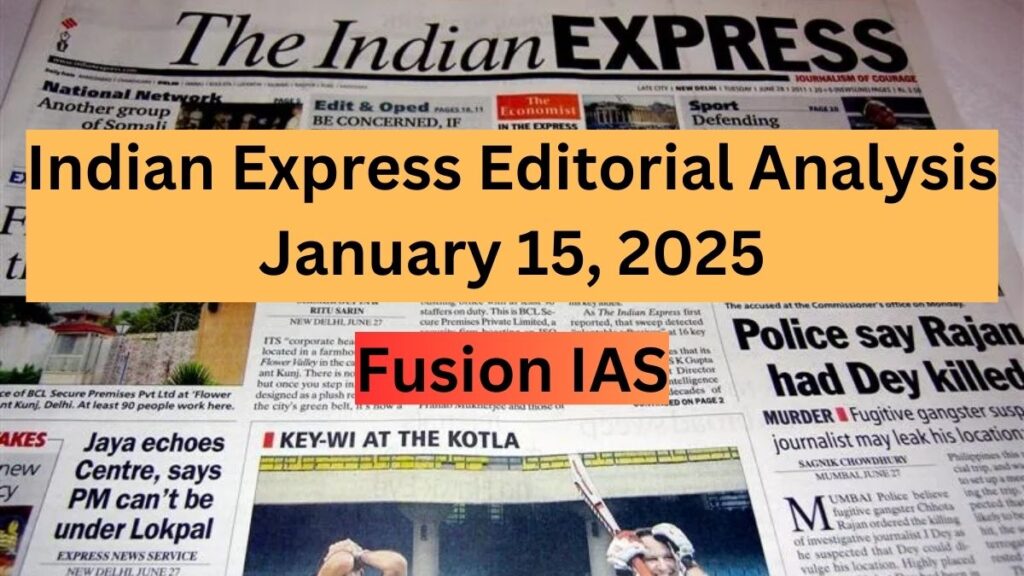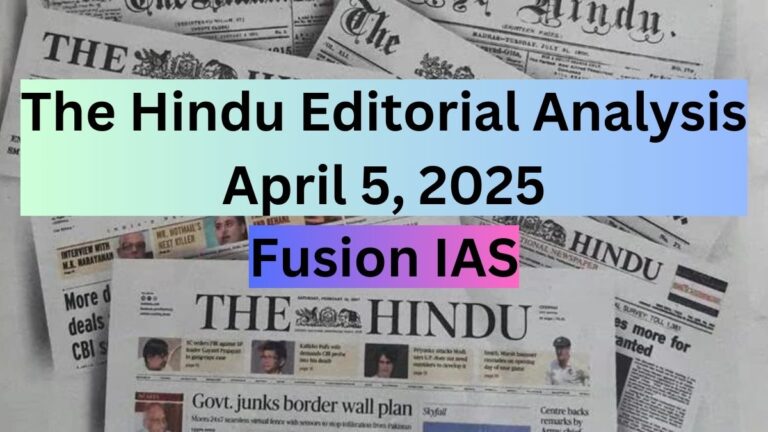
For UPSC CSE aspirants, analyzing editorials from The Indian Express is essential to build a comprehensive understanding of current affairs, policy debates, and socio-economic challenges. Here’s a structured breakdown of the editorial themes covered on January 15, 2025, tailored for UPSC preparation:
1. From Gen Z to Gen Beta: Cynicism, activism and a whole lot of hope
This article explores the transition of Gen Z from mentees to mentors as they pass the torch to Generation Beta, born between 2025 and 2039. It reflects on the challenges, activism, and leadership demonstrated by Gen Z in 2024, including protests for justice, climate action, and consumer-led accountability. The article questions the legacy Gen Z will leave for future generations and highlights the need for hope and compassion in shaping a better future.
- Generational Transition:
- 2025 marks the beginning of Generation Beta (born between 2025-2039).
- Gen Z transitions from mentee to mentor, navigating economic, social, and political challenges.
- Key Themes from 2024:
- Protests against Kolkata rape and murder case demanding justice and better women’s safety.
- Student protests over NEET and civil services exam irregularities, including paper leaks.
- Support for Palestine through boycotting brands like McDonald’s and Coca-Cola.
- Climate activism targeting unsustainable brands like SHEIN and SKIMS.
- Youth Leadership:
- Chappell Roan advocated for trans rights and healthy fan relationships.
- Disha Ravi led climate activism and represented India at global forums.
- Challenges Faced by Gen Z in 2024:
- Dwindling employment opportunities and climate injustices.
- Politically divisive rhetoric and activism fatigue.
- Legacy Questions:
- Will Gen Alpha and Gen Beta face ridicule or inherit compassion?
- What critical legacy will Gen Z leave behind as mentors?
- Impact of Youth Movements:
- Highlighted justice, accountability, and power of consumer activism in addressing systemic issues.
- Reflection for 2025:
- Growing cynicism and realistic aspirations among Gen Z.
- Importance of radical optimism in shaping the future.
2. C Raja Mohan writes: Delhi must look beyond H-1B
This article delves into the broader implications of Donald Trump’s potential second term as US President, emphasizing the need for India to move beyond the H-1B visa debate. It highlights how Trump’s technology policies, including intensified US-China tech competition, the rise of techno-libertarians, and shifting global governance dynamics, could reshape the international socio-economic and geopolitical order. India’s strategic alignment with these changes, particularly in the tech sector, will be crucial in navigating the evolving global landscape.
3. California fires are a reminder of lines we must not cross
This article reflects on the recurring wildfires in California as a symbol of broader crises, including environmental degradation, societal polarization, and the consequences of misplaced priorities in governance. It critiques the state’s failure to balance progress with sustainability, highlighting the disconnect between addressing immediate local issues and broader ideological conflicts. The piece calls for a return to ecological and cultural values, emphasizing respect for nature’s limits and the need for grounded, holistic approaches to modern challenges.
- California Fires as a Symptom of Larger Issues:
- Wildfires in California represent a broader crisis, not just a regional disaster.
- The crisis reflects issues related to human competence, civic management, and the sanctity of life in the social media age.
- Impact of California Wildfires on Life:
- Wildfires in California have become a regular occurrence, with the state constantly in a state of readiness for evacuation.
- The fires serve as a reminder of the vulnerability of human life and the environment in the face of natural disasters.
- Social Media and Its Role in Shaping Reality:
- Social media’s influence on shaping political and social realities, often blurring the line between facts and opinions.
- Polarisation in American society, with different groups attributing California’s fires to causes such as “climate change” or “wokeism.”
- The spread of memes and misinformation through social media, leading to confusion and distortion of reality.
- Crisis of Competence and Leadership:
- California’s civic management is marked by incompetence and a lack of focus on addressing real issues like fire risks.
- Political discourse is distracted by global issues, such as Israel’s stance or India’s Citizenship Amendment Act, rather than local concerns like fire prevention.
- Loss of Cultural and Spiritual Values:
- California’s sense of place, culture, and spirituality is eroding, replaced by a technocratic and psycho-political approach.
- The loss of connection to nature and traditional values in the face of unchecked development and technocratic governance.
- Critique of Technocratic Governance and Progress Ideology:
- The ideology of progress and the belief that humanity knows more than previous generations is challenged.
- The destructive force of fire as a metaphor for the consequences of ignoring the sacred balance between nature and human development.
- Connection to Global Environmental Activism:
- Parallel between California’s environmental destruction and global indigenous ecological activism, which seeks to preserve natural balance and respect for nature.
- Reference to the need for policies that safeguard the environment and cultural values, seen in both local and global contexts.
- Reflection on Causality and Accountability:
- The need to confront the truth about how disasters like fires are often the result of human carelessness, arson, or greed, rather than pseudo-causal explanations like climate change denial.
- A call for accountability and rational discourse in addressing the real causes of environmental crises.
- Restoration of Spiritual and Cultural Connection:
- The importance of reconnecting with cultural and spiritual roots, symbolized by terms like “Tamaayawut” (in Tongva) or “Bhu-Devi” (in Telugu), to restore balance and understanding of humanity’s place in the world.
4. Express view on J&K infra push: Delhi and Valley
The editorial discusses the Centre’s ongoing infrastructure push in Jammu and Kashmir (J&K) following the abrogation of Article 370. It highlights significant road development projects, including national highways, aimed at boosting the region’s economy through tourism and small businesses. The political landscape is marked by a pragmatic approach from Chief Minister Omar Abdullah, who seeks the restoration of statehood but remains cautious in his dealings with the Centre. The article also addresses the broader implications of J&K’s relationship with Delhi and the Centre’s commitment to fulfilling its promises regarding both economic development and political autonomy.
- Jammu & Kashmir Infrastructure Push:
- The Centre’s emphasis on infrastructure development in Jammu and Kashmir (J&K) post-abrogation of Article 370 is a positive move.
- Initiatives include road development projects worth more than Rs 40,000 crore, including national highways, signaling the government’s commitment to improving the region’s economic prospects.
- Focus on Tourism and Small Business:
- The government recognizes tourism’s potential in boosting employment, supporting small businesses, and improving J&K’s finances.
- This focus aligns with broader economic strategies for the region, aiming to address its critical infrastructure needs.
- Political Context and CM’s Response:
- Despite the controversial nature of the abrogation of Article 370, the development push is being viewed as a constructive step.
- Chief Minister Omar Abdullah, after the October 2024 election results, has adopted a non-confrontational approach toward the Centre. He is pragmatic, recognizing the region’s reliance on the government of India due to its fiscal deficit.
- Restoration of Statehood Debate:
- The demand for the restoration of J&K’s statehood remains a central political issue. While PM Modi refrained from giving a time frame, he stated that the “distance between Delhi and the Valley has been erased,” signaling improved central-state relations.
- Abdullah maintains that restoration of statehood is a priority but prefers to wait for the Centre’s actions rather than resorting to legal avenues.
- Public Perception and Political Dynamics:
- There is an ongoing balancing act in J&K politics, with the local leadership navigating the delicate situation of limited powers within the Union Territory.
- Both PM Modi and CM Abdullah’s recent public interactions suggest a desire for collaboration and a shift from confrontation to constructive engagement.
- Centre’s Commitments to J&K:
- PM Modi’s statement that “everything has a time, the right things will happen at the right time” reflects the Centre’s cautious approach towards fulfilling its political promises regarding statehood restoration.
- The government’s actions, both economic and political, will be closely monitored, both within J&K and outside, to assess how effectively it meets its commitments.
5. Express view on variable pay in cricket: An unnecessary sticky wicket
The proposal to introduce variable pay in Indian cricket, linking player salaries to individual performance metrics like runs and wickets, has sparked debate. While intended to boost motivation and prevent stagnation, this approach is criticized for undermining the team spirit and complexity inherent in the game, shifting focus from collective effort to individual statistics.
- Variable Pay in Cricket:
- The proposal for a performance-based pay structure in Indian cricket, based on individual player performance (wickets, runs), has raised concerns. It could lead to players facing pay cuts if they do not meet performance standards.
- The underlying logic is that uncertainty in pay keeps players motivated, prevents stagnation, and encourages consistent performance.
- Criticism of the Variable Pay System:
- The concept of variable pay in cricket is seen as a non-cricketing solution to a cricketing problem. Cricket is inherently a team sport, and the focus should be on collective effort rather than individual performance metrics.
- Cricket, unlike corporate settings, does not have set performance targets. The game is complex, and statistics can be interpreted in multiple ways. For example, a century in an easier situation may not be as valuable as a gritty 40 in tougher conditions.
- Complexity of Cricket Performance:
- The value of a player’s performance can vary based on numerous factors like pitch conditions, the opposition, and even umpiring decisions, which are hard to quantify numerically.
- The proposed system could lead to excessive reliance on performance analysts and grading systems, turning cricket into a numbers-driven exercise that diminishes the spirit of the sport.
- Impact on Team Dynamics:
- A focus on individual performance metrics might erode the collective spirit of the team, as players could prioritize personal stats over the team’s success.
- It could also encourage players to move towards lucrative franchise cricket leagues, where individual performance and monetary rewards are more prominent, thus undermining the traditional structure of red-ball cricket.
- Need for Game-Specific Solutions:
- The focus should be on addressing game-specific issues, such as the vulnerability of Indian batsmen to spinners, the lack of depth in the seam-bowling department, and the overall effectiveness of the domestic system.
- Rather than implementing corporate-style gimmicks like variable pay, the Indian cricket board needs to consider deeper, more relevant questions and reforms to improve the team’s performance and structure.
- Conclusion:
- The introduction of variable pay in cricket could ultimately shift the focus from the game’s intrinsic values and team dynamics to financial incentives tied to individual performance, which may not necessarily lead to long-term improvement in Indian cricket.
Disclaimer:
This analysis is based on the editorial content published in Indian Express and is intended solely for informational and educational purposes. The views, opinions, and interpretations expressed herein are those of the author of original article. Readers are encouraged to refer to the original article for complete context and to exercise their own judgment while interpreting the analysis. The analysis does not constitute professional advice or endorsement of any political, economic, or social perspective.
Follow Fusion IAS


